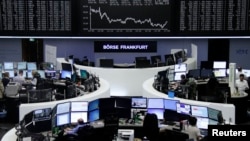It seems that the strong start to the year was another false dawn for the eurozone economy and that the European Central Bank will have more to do in the months ahead to shore up growth.
New figures released Friday confirmed that the eurozone, which is made up of 19 countries from Ireland to the west to Cyprus in the east, suffered a sizeable slowdown in the second quarter of the year despite a number of stimulus measures that the European Central Bank has thrown at it.
In its first estimate for the April to June period, Eurostat, the EU's statistics agency, said growth across the single currency bloc eased to a quarterly rate of 0.3 percent from the previous quarter's 0.6 percent.
The decrease was in line with market expectation and the euro was steady at around $1.11.
No explanation for the slowdown was provided in the figures but analysts said growth was likely hurt by a moderation in the tailwinds that had helped the region in the first quarter. The sharp drop in oil prices has reversed slightly, meaning that the boon to households and businesses has largely played out. And the dividend from the previous export-boosting depreciation in the value of the euro has diminished as the currency has steadied.
The June 23 referendum in Britain may have also caused some uncertainty, prompting businesses to delay investment decisions. The evidence since confirmation that Britain voted to leave the EU shows that Europe has brushed aside much of the uncertainty generated by the decision.
However, most forecasters think it will weigh to some degree on growth over the coming months, especially if the discussions around Brexit drag. As a result, many economists think the ECB will back a further stimulus package at its next policy meeting on September 8.
“The weakening in economic growth, together with the downward revisions in expectations for the outlook are setting the scene for more stimulus measures,” said Danae Kyriakopoulou, managing economist at the Center for Economics and Business Research in London.
Kyriakopoulou estimates that the ECB will more likely expand its bond-buying stimulus program rather than further cut its interest rates, which have the potential to undermine bank profitability.
The results of stress tests of EU banks, due to be published later Friday by the European Banking Authority, are expected to show that many banks in the region, particularly in Italy, are struggling with the super-low interest rates, which have fallen further since the Brexit vote. The ECB earlier this year cut its main interest rate to zero and has pushed the rate it charges banks to park their cash at the central bank below zero, meaning they have to pay for the luxury.
The ECB could choose to expand its current bond-buying stimulus program beyond its current expiry date of March 2017 or increase the amount of bonds it purchases each month from 80 billion euros ($88 billion). The program pumps newly created money into the banking system in the hope it will increase lending and raise inflation to levels more consistent with steady growth.
One moderately bright spot for policymakers at the ECB is that inflation is heading the right way.
A separate Eurostat report showed consumer prices across the region rose to 0.2 percent in the year to July from the previous month's 0.1 percent. The core rate, which strips out volatile items such as food, alcohol, energy and tobacco, held steady at 0.9 percent.
Though the headline rate is still far short of the ECB's target of just below 2 percent, the prospect of falling prices has diminished over the past few months, largely because the sharp decline in oil prices seen last year has come to an end.
The main motivation behind the ECB's stimulus efforts over the past couple of years was to make sure that prices don't actually fall over a long period of time. So-called deflation can weigh on economic activity as consumers delay spending in anticipation of lower prices further out and businesses grow increasingly reluctant to invest and hire.
Recent evidence has shown that they have grown more inclined to hire.
The eurozone's recovery from recession over the past two to three years has helped unemployment across the region fall at a steady if unspectacular rate. Eurostat figures on Friday showed that the number of people out of work in the eurozone dropped by 37,000 in June to 16.27 million but that the unemployment rate held steady at near five-year lows of 10.1 percent.
Eurozone Likely to See Another Stimulus as Growth Halves

LONDON —





